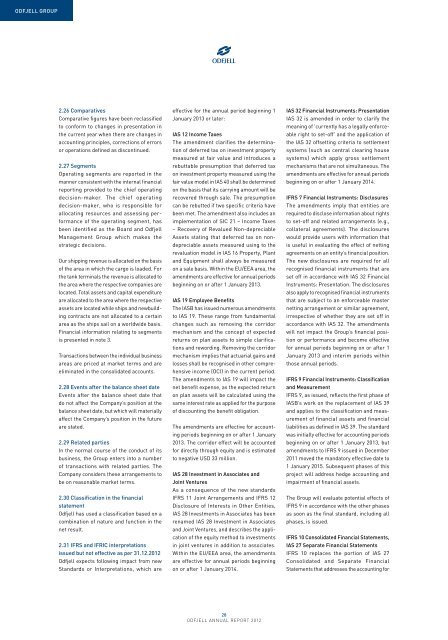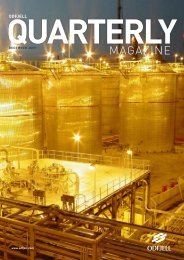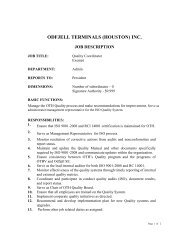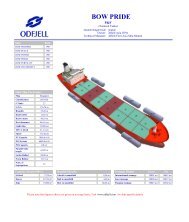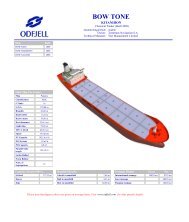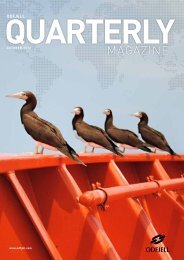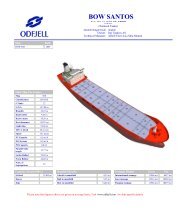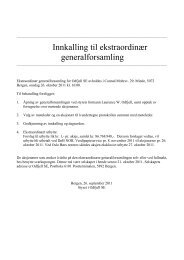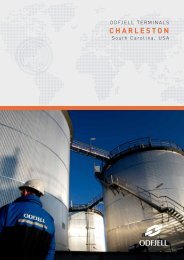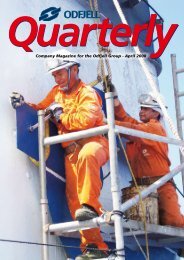Odfjell SE Annual Report 2012
Odfjell SE Annual Report 2012
Odfjell SE Annual Report 2012
Create successful ePaper yourself
Turn your PDF publications into a flip-book with our unique Google optimized e-Paper software.
odfjell group<br />
2.26 Comparatives<br />
Comparative figures have been reclassified<br />
to conform to changes in presentation in<br />
the current year when there are changes in<br />
accounting principles, corrections of errors<br />
or operations defined as discontinued.<br />
2.27 Segments<br />
Operating segments are reported in the<br />
manner consistent with the internal financial<br />
reporting provided to the chief operating<br />
decision-maker. The chief operating<br />
decision-maker, who is responsible for<br />
allocating resources and assessing performance<br />
of the operating segment, has<br />
been identified as the Board and <strong>Odfjell</strong><br />
Management Group which makes the<br />
strategic decisions.<br />
Our shipping revenue is allocated on the basis<br />
of the area in which the cargo is loaded. For<br />
the tank terminals the revenue is allocated to<br />
the area where the respective companies are<br />
located. Total assets and capital expenditure<br />
are allocated to the area where the respective<br />
assets are located while ships and newbuilding<br />
contracts are not allocated to a certain<br />
area as the ships sail on a worldwide basis.<br />
Financial information relating to segments<br />
is presented in note 3.<br />
Transactions between the individual business<br />
areas are priced at market terms and are<br />
eliminated in the consolidated accounts.<br />
2.28 Events after the balance sheet date<br />
Events after the balance sheet date that<br />
do not affect the Company’s position at the<br />
balance sheet date, but which will materially<br />
affect the Company’s position in the future<br />
are stated.<br />
2.29 Related parties<br />
In the normal course of the conduct of its<br />
business, the Group enters into a number<br />
of transactions with related parties. The<br />
Company considers these arrangements to<br />
be on reasonable market terms.<br />
2.30 Classification in the financial<br />
statement<br />
<strong>Odfjell</strong> has used a classification based on a<br />
combination of nature and function in the<br />
net result.<br />
2.31 IFRS and IFRIC interpretations<br />
issued but not effective as per 31.12.<strong>2012</strong><br />
<strong>Odfjell</strong> expects following impact from new<br />
Standards or Interpretations, which are<br />
effective for the annual period beginning 1<br />
January 2013 or later:<br />
IAS 12 Income Taxes<br />
The amendment clarifies the determination<br />
of deferred tax on investment property<br />
measured at fair value and introduces a<br />
rebuttable presumption that deferred tax<br />
on investment property measured using the<br />
fair value model in IAS 40 shall be determined<br />
on the basis that its carrying amount will be<br />
recovered through sale. The presumption<br />
can be rebutted if two specific criteria have<br />
been met. The amendment also includes an<br />
implementation of SIC 21 – Income Taxes<br />
– Recovery of Revalued Non-depreciable<br />
Assets stating that deferred tax on nondepreciable<br />
assets measured using to the<br />
revaluation model in IAS 16 Property, Plant<br />
and Equipment shall always be measured<br />
on a sale basis. Within the EU/EEA area, the<br />
amendments are effective for annual periods<br />
beginning on or after 1 January 2013.<br />
IAS 19 Employee Benefits<br />
The IASB has issued numerous amendments<br />
to IAS 19. These range from fundamental<br />
changes such as removing the corridor<br />
mechanism and the concept of expected<br />
returns on plan assets to simple clarifications<br />
and rewording. Removing the corridor<br />
mechanism implies that actuarial gains and<br />
losses shall be recognised in other comprehensive<br />
income (OCI) in the current period.<br />
The amendments to IAS 19 will impact the<br />
net benefit expense, as the expected return<br />
on plan assets will be calculated using the<br />
same interest rate as applied for the purpose<br />
of discounting the benefit obligation.<br />
The amendments are effective for accounting<br />
periods beginning on or after 1 January<br />
2013. The corridor effect will be accounted<br />
for directly through equity and is estimated<br />
to negative USD 33 million.<br />
IAS 28 Investment in Associates and<br />
Joint Ventures<br />
As a consequence of the new standards<br />
IFRS 11 Joint Arrangements and IFRS 12<br />
Disclosure of Interests in Other Entities,<br />
IAS 28 Investments in Associates has been<br />
renamed IAS 28 Investment in Associates<br />
and Joint Ventures, and describes the application<br />
of the equity method to investments<br />
in joint ventures in addition to associates.<br />
Within the EU/EEA area, the amendments<br />
are effective for annual periods beginning<br />
on or after 1 January 2014.<br />
IAS 32 Financial Instruments: Presentation<br />
IAS 32 is amended in order to clarify the<br />
meaning of 'currently has a legally enforceable<br />
right to set-off' and the application of<br />
the IAS 32 offsetting criteria to settlement<br />
systems (such as central clearing house<br />
systems) which apply gross settlement<br />
mechanisms that are not simultaneous. The<br />
amendments are effective for annual periods<br />
beginning on or after 1 January 2014.<br />
IFRS 7 Financial Instruments: Disclosures<br />
The amendments imply that entities are<br />
required to disclose information about rights<br />
to set-off and related arrangements (e.g.,<br />
collateral agreements). The disclosures<br />
would provide users with information that<br />
is useful in evaluating the effect of netting<br />
agreements on an entity’s financial position.<br />
The new disclosures are required for all<br />
recognised financial instruments that are<br />
set off in accordance with IAS 32 Financial<br />
Instruments: Presentation. The disclosures<br />
also apply to recognised financial instruments<br />
that are subject to an enforceable master<br />
netting arrangement or similar agreement,<br />
irrespective of whether they are set off in<br />
accordance with IAS 32. The amendments<br />
will not impact the Group’s financial position<br />
or performance and become effective<br />
for annual periods beginning on or after 1<br />
January 2013 and interim periods within<br />
those annual periods.<br />
IFRS 9 Financial Instruments: Classification<br />
and Measurement<br />
IFRS 9, as issued, reflects the first phase of<br />
IASB’s work on the replacement of IAS 39<br />
and applies to the classification and measurement<br />
of financial assets and financial<br />
liabilities as defined in IAS 39. The standard<br />
was initially effective for accounting periods<br />
beginning on or after 1 January 2013, but<br />
amendments to IFRS 9 issued in December<br />
2011 moved the mandatory effective date to<br />
1 January 2015. Subsequent phases of this<br />
project will address hedge accounting and<br />
impairment of financial assets.<br />
The Group will evaluate potential effects of<br />
IFRS 9 in accordance with the other phases<br />
as soon as the final standard, including all<br />
phases, is issued.<br />
IFRS 10 Consolidated Financial Statements,<br />
IAS 27 Separate Financial Statements<br />
IFRS 10 replaces the portion of IAS 27<br />
Consolidated and Separate Financial<br />
Statements that addresses the accounting for<br />
28<br />
odfjell annual report <strong>2012</strong>


